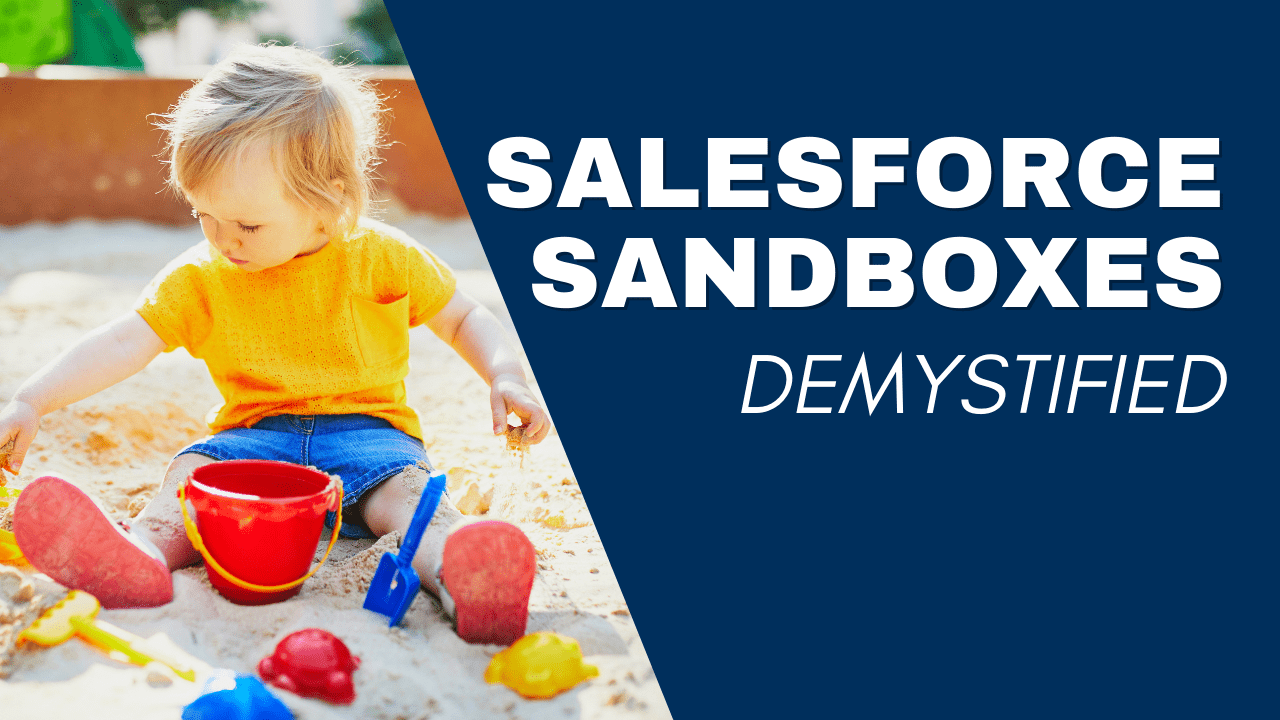Salesforce Sandboxes FAQs

What Is a Salesforce Sandbox?
A Salesforce Sandbox is an isolated environment that allows developers to test their code securely and reliably without affecting the production environment. This means Salesforce Admins and Developers can safely deploy and test new features, coding changes, and integrations without disrupting existing business processes. The sandbox also ensures that data integrity is maintained, as any changes to the data are not propagated to the primary production system until they have been tested and certified.
Sandboxes are typically used for development or testing by mimicking a production environment or setting up a new instance of Salesforce for experimentation. Sandboxes can also be used to prepare for upgrades or migrations from one version of Salesforce to another. Furthermore, sandboxes are often used as staging environments where updates such as customizations, configurations, integrations, and other development activities can be deployed before going into production.
Overall, Salesforce Sandbox is an essential tool for any organization running on its platform as it enables developers to make necessary changes without compromising their production environment. It ensures that any modifications done in the sandbox environment are thoroughly tested before going live, which helps improve the reliability, accuracy, and performance of the system overall.
🔥 SUBSCRIBE! 🔥

Get practical Salesforce advice in your inbox!
Feeling overwhelmed by everything you have to do as a Salesforce Admin?
I know how it feels.
I created the FREE Brainiate Newsletter – to help you stay up-to-date with the latest Salesforce news, advice, and product recommendations.
Sign up for my newsletter and get all that information right in your inbox – without having to search for it yourself. You’ll be able to focus on your projects with peace of mind, knowing you’re always up-to-date on the latest Salesforce updates.
Click the button below and sign up for my FREE Brainiate Newsletter today!

What Are the Different Types of Salesforce Sandboxes?
Salesforce provides several sandboxes: Developer, Developer Pro, Partial Copy, and Full copy.
Developer sandbox
Developer Sandboxes give you an exciting 200MB storage allowance to experiment with- so let your creativity flow! Remember that only metadata will be copied into the sandbox, and these sandboxes can’t be used with templates. But don’t worry; every day, you have the opportunity to refresh these sandboxes if needed.
Developer pro sandbox
Get ready to take your development projects to the next level with Developer Pro Sandboxes! Packed with 1GB of data and file storage, metadata is automatically copied upon sandbox creation. Plus, you get daily refreshes for an always up-to-date environment – that’s a great way to stay ahead in any project!
NEED A CAREER BOOST?

Jumpstart your future as a Salesforce professional today!
Are you looking for the best way to expand your job prospects and capitalize on the growing career opportunities in the Salesforce market?
Look no further!
This course will give you all the skills, knowledge, and on-the-job expertise you need to succeed as a Salesforce Admin.
Partial copy sandbox
Partial Copy sandboxes are the perfect way to get started when starting a new project or testing an idea! When creating a Partial Copy Sandbox, your metadata and sample data get copied.
With up to 5GB of data and file storage identical to your production org, you can quickly create these environments using pre-made sandbox templates. The best part? You can refresh them every five days for extra peace of mind!
Full sandbox
Get the same data storage and file limits as your production org with a Full Sandbox! With this sandbox type, you’ll get metadata and all existing data copied. Plus, customize it to fit your needs by using one of our available templates – plus, they can be refreshed every 29 days for even more control.
SNAG THESE EMAIL TEMPLATES

200+ project management templates to help you get organized and increase your productivity!
Are you tired of wasting time writing the same email messages repeatedly?
I know your time is valuable, so I’ve created email templates specifically for Salesforce Admins to help you manage your Salesforce projects more efficiently.
Use these templates as a starting point or adapt them to fit your own needs. And you can cut and paste them into whatever email system you need.
Stop wasting time on menial tasks and start managing your projects more effectively.
Get access to a vast library of email templates to painlessly manage the entire project lifecycle!
What Are Some of the Best Practices for Working With Salesforce Sandboxes?
Salesforce sandboxes are a powerful tool for businesses, allowing them to test changes and new features without impacting the production environment. However, using a sandbox responsibly is essential to ensure the best outcomes and maximum efficiency. Here are some of the best practices for working with Salesforce Sandboxes:
1) Establish a Clear Strategy: Before starting work in Salesforce sandboxes, ensure you have a clear plan of what you want to accomplish. Having an established strategy helps ensure that no time is wasted making unnecessary changes or experimenting with features that don’t help meet your goals. Additionally, it’s essential to create and document processes so future users can understand them easily.
2) Properly Monitor Your Sandbox: It’s essential to continuously monitor your Salesforce sandbox environment as you work on it. This includes ensuring that data is not shared across different sandboxes (when it shouldn’t be), that all activities are correctly tracked, and that no unauthorized access is occurring within the system.
3) Train Users Properly: To maximize efficiency and limit potential human errors in Salesforce sandboxes, all users must be appropriately trained before using the environment. Make sure everyone understands how their actions will impact the entire system and how they should use its various features correctly.
4) Restrict Access As Needed: To maintain security in your Salesforce sandbox environment, it’s important to set user permissions carefully so that only specific users can access certain functionalities at certain times. Additionally, consider encrypting any sensitive data stored in your sandbox environment so as not to risk its exposure if hackers gain access somehow.
By following these best practices when working with Salesforce Sandboxes, businesses can ensure that they get the most out of their environment while maintaining maximum security. Doing so ensures smoother functioning of processes and increased efficiency across all departments involved in using this powerful system.
What Are Some of the Common Issues With Salesforce Sandboxes?
One of the most common issues with Salesforce Sandboxes is their size. Sandboxes are usually limited to a specific size, so organizations may not be able to replicate their entire production environment within the sandbox. This can cause errors when moving components between production and sandbox environments due to incompatibilities with existing data or code. Additionally, Salesforce sandboxes may not always have the same features and capabilities as production environments, so testing new features or updates could be difficult without access to the full functionality in production.
Another common issue with Salesforce Sandboxes is their time limitation. Sandboxes are often set up for specific periods and must be refreshed periodically, making it difficult for organizations to keep up-to-date with changes in the production environment. As a result, sandbox refreshes can take longer than expected and require additional monitoring to ensure that everything is up-to-date before users start working on it. This can also lead to increased maintenance costs associated with keeping the sandbox environment current.
Finally, there’s also the issue of the data accuracy within Salesforce sandboxes. Since these environments are often used for testing purposes, some data may not be accurate or realistic enough for production deployment. Ensuring that all test data accurately reflects real-world conditions can be challenging, as it requires careful debugging and validation before deploying anything into production. This process can add extra overhead if organizations aren’t prepared for it.






